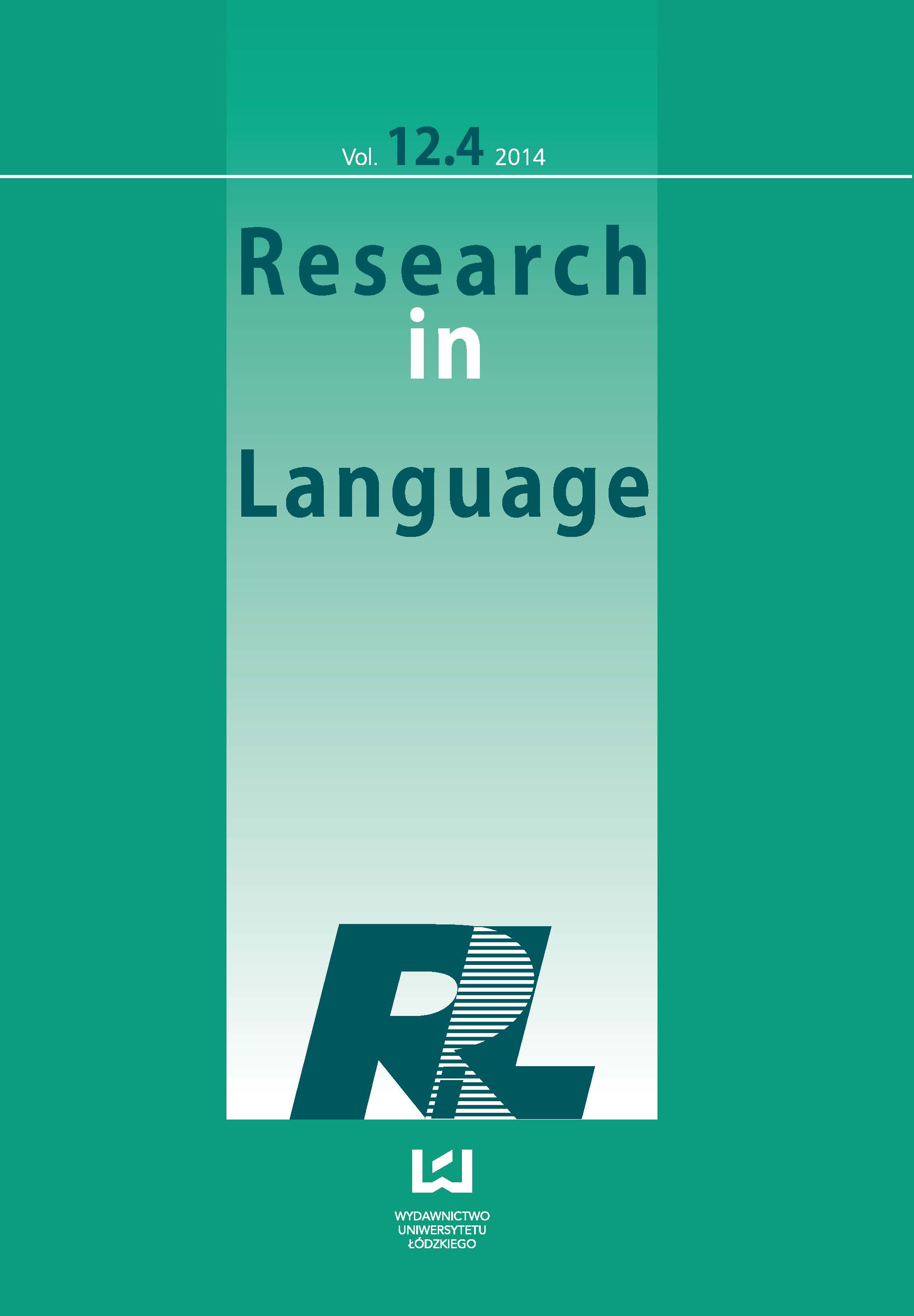Degrees of Propositionality in Construals of Time Quantities
DOI:
https://doi.org/10.1515/rela-2015-0003Keywords:
time, temporal expressions, cognitive linguistics, Polish, corpus linguistics, conceptualisation, EnglishAbstract
The paper investigates the possible conceptual bases of differences between seemingly synonymous and easily definable temporal expressions. Looking at the usage patterns of nominal temporal phrases in reference corpora of English and Polish we attempt to relate these subtleties to the different granularity of the cognitive scales on which construals of time quantities in general are based. More specifically, we focus on a subset of nominal temporal expressions which adhere to the “number + time unit” pattern, matching what Haspelmath (1997: 26) describes as “culture-bound artificial time units”. Using the British National Corpus (BNC) and the National Corpus of Polish (NCP), we first analyse both the variation and the regularity found in naturally-occurring samples of Polish and English. Finally, we compare the patterns of use emerging from the two corpora and arrive at cross-linguistic generalisations about the conceptualisation of time quantities.
References
Alverson, Hoyt 1994. Semantics and experience: Universal metaphors of time in English, Mandarin, Hindi, and Sesotho. Baltimore: Johns Hopkins University Press.
Google Scholar
Casasanto, Daniel & Lera Boroditsky. 2008. Time in the mind: Using space to think about time, Cognition 106, 579–593.
Google Scholar
Clark, Herbert H. 1973. Space, time, semantics and the child, In T. E. Moore (Ed.), Cognitive development and the acquisition of language. New York: Academic Press, 27–63.
Google Scholar
Dehaene, Stanislas & Jacques Mehler 1992. Cross-linguistic regularities in the frequency of number words, Cognition, 43: 1–29.
Google Scholar
Davidson, Donald 1967. Truth and meaning, Synthese 17(3), 304–323.
Google Scholar
Evans, Vyvyan 2004. The structure of time. Amsterdam and Philadelphia: John Benjamins.
Google Scholar
Evans, Vyvyan 2013. Temporal frames of reference, Cognitive Linguistics 24(3), 393–435.
Google Scholar
Evans, Vyvyan & Melanie Green 2006. Cognitive Linguistics: An Introduction. Mahwah, NJ and Edinburgh: Lawrence Erlbaum Associates/Edinburgh University Press.
Google Scholar
Everett, Caleb & Madora, Keren 2012. Quantity recognition among speakers of an anumeric language, Cognitive Science 36: 1, 130–141.
Google Scholar
Everett, Caleb 2013. Linguistic relativity and numeric cognition: New light on a prominent test case, Proceedings of the 37th Annual Meeting of the Berkeley Linguistics Society, 91–103
Google Scholar
Geeraerts Dirk & Hubert Cuyckens 2007. (eds.) The Oxford Handbook of Cognitive Linguistics. Oxford: Oxford University Press.
Google Scholar
Geeraerts, Dirk 2006. (ed.) Cognitive Linguistics: Basic Readings. Berlin and New York: Mouton de Gruyter.
Google Scholar
Gelman, Rochel & Gallistel, Randy C. 1978. The Child’s Understanding of Number. Cambridge, MA. Harvard University Press.
Google Scholar
Gruber, Jeffrey 1965. Studies in lexical relations. Cambridge: MIT.
Google Scholar
Haspelmath, Martin 1997. From space to time: Temporal adverbials in the world’s languages. Munich and Newcastle: Lincom Europa.
Google Scholar
Lakoff, George, & Johnson, Mark 1980. Metaphors we live by. Chicago: University of Chicago Press.
Google Scholar
Langacker, Ronald W. 1987. Foundations of cognitive grammar. Vol. 1, Theoretical prerequisites. Stanford, CA: Stanford University Press.
Google Scholar
Langacker, Ronald W. 2008. Cognitive Grammar: A Basic Introduction. New York: Oxford University Press.
Google Scholar
Pęzik, Piotr 2012. Wyszukiwarka PELCRA dla danych NKJP. In Adam Przepiórkowski, Mirosław Bańko, Rafał Górski, and Barbara Lewandowska-Tomaszczyk (eds.) Narodowy Korpus Języka Polskiego, Warszawa: Wydawnictwo Naukowe PWN, 253–279.
Google Scholar
Pica, Pierre, Lemer, Cathy, Izard, Véronique & Stanislas, Dehaene 2004. Exact and approximate arithmetic in an Amazonian indigene group. Science 306, 499–503.
Google Scholar
Sarnecka, Barbara W. & Carey, Susan 2008. How counting represents number: What children must learn and when they learn it, Cognition, 108, 662–667.
Google Scholar
Szabó, Zoltán G. 2013. Compositionality, In Edward N. Zalta (ed.) The Stanford Encyclopedia of Philosophy.
Google Scholar
Werning, Markus 2012. Non-Symbolic Compositional Representation and Its Neuronal Foundations: Towards an Emulative Semantics, In Markus Werning, Wolfram Hinzen, and Edouard Machery (eds.) The Oxford Handbook of Compositionality, Oxford Handbooks in Linguistics. Oxford New York, NY: Oxford University Press, 633–724.
Google Scholar
Downloads
Published
How to Cite
Issue
Section
License

This work is licensed under a Creative Commons Attribution-NonCommercial-NoDerivatives 4.0 International License.










